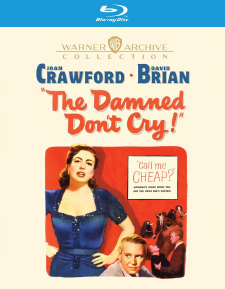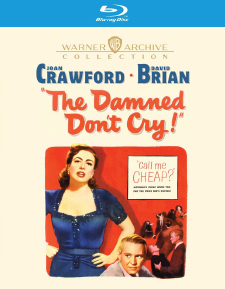Damned Don’t Cry, The (Blu-ray Review)

Director
Vincent ShermanRelease Date(s)
1950 (June 27, 2023)Studio(s)
Warner Bros (Warner Archive Collection)- Film/Program Grade: B
- Video Grade: A
- Audio Grade: B+
- Extras Grade: B
Review
With her Academy Award for Mildred Pierce, Joan Crawford was enjoying a resurgence of her career in 1950 when she starred in The Damned Don’t Cry. The role allowed her to play both a beleaguered housewife and a glamorous social climber.
Ethel Whitehead (Crawford) is in a troubled marriage to blue-collar husband Roy (Richard Egan), who shows little ambition to get ahead and criticizes Ethel for spending money on a bicycle for their young son, Tom. When a tragedy occurs, Ethel realizes this is her chance to get out and make a fresh start. She heads for New York City, where she uses her intelligence, charm, and good looks to move from a job as store clerk to a model for a fashion wholesaler. Fellow model Sandra (Jacqueline deWit) suggests that Ethel accept dates with men who do business with the company. On one such date at a swanky restaurant, she meets CPA Martin Blackford (Kent Smith), a decent guy but only a low-paid worker.
With Ethel’s prodding, Martin gets a job moonlighting as the accountant for the restaurant’s owner. He does such a fine job that soon he gets a lot of work through recommendations. However, Martin is concerned because many of his new clients are gangsters who run legitimate businesses as a front. He sticks with it because he’s fallen in love with Ethel and knows that’s what she wants. Ethel soon sets her sights on big-time crime boss George Castleman (David Brian), spurns Martin, and becomes the married gangster’s mistress. Castleman bankrolls Ethel’s transformation into a convincing facsimile of a socialite and Texas oil heiress with the name Lorna Hansen Forbes.
When Castleman suspects that the head of his syndicate’s West Coast branch, Nick Prenta (Steve Cochran), is planning something nefarious, he sends Lorna out to ingratiate herself with Nick, nose around, and report on Nick’s schemes. Matters come to a head when “Lorna” realizes her spying is likely to result in murder.
Crawford does quite a good job as Ethel/Lorna, transforming from poor housewife to striving shop girl to the envy of high society. As Ethel, she’s trapped in a miserable life, with a controlling husband and a dull routine, and she jumps at the opportunity to leave her gloomy life behind. Relying on her ambition, intelligence, and beauty, she’s determined to make it in the Big Apple. As Lorna, she’s movie star Crawford, with aristocratic bearing, patrician elegance, and of course beautiful dresses. Dialogue is often raw and earthy, and Crawford adapts her manner of speaking between Ethel and Lorna. Ethel is a deeply unhappy woman and speaks with an underlying sadness in her voice. As Lorna, she blossoms among the wealthy and social elite. There are elements in her performance of the many shop girl roles she played early in her career.
All four male leads are character actors, not stars, so they never draw attention away from their leading lady. Egan is gruff, controlling, and impatient with his wife. Smith plays a role he built a career on—the mild-mannered nice guy. Brian shows two sides of Castleman’s personality—the charming businessman and the sadistic thug. Cochran’s Nick conveys power and arrogance as a syndicate boss. But all four serve Ethel’s story without dimming Crawford’s luster. This is clearly Crawford’s film.
Director Vincent Sherman and writers Harold Medford and Jerome Weidman have fashioned a quick- paced thriller that suggests Warner’s gangster films of the 30s. There are no dead spots, with each scene accomplishing its purpose and moving on briskly to the next. Sherman has staged a good deal of movement within scenes, so Crawford is seldom static. Whether modeling a dress, driving, promenading through a nightclub, swimming in a pool, being pummeled, or storming out of her dead-end marriage, she brings an intensity of purpose to her performance. Crawford is in nearly every scene.
The Damned Don’t Cry was shot by director of photography Ted McCord with spherical lenses on 35 mm black-and-white film and presented in the aspect ratio of 1.37:1. The Blu-ray features a new 4K restoration of the film from the original camera negative. Picture quality is excellent with extremely good detail. Crawford is given movie star lighting in her Lorna persona. Her glamour is significantly tamped down in her early scenes as hausfrau Ethel. A few key scenes are shot in low light to enhance suspense and to mask stunt men standing in for the stars in a fight. Most scenes are interiors, but an early scene depicting a tragedy is filmed outdoors on an actual street.
The soundtrack is English 2.0 DTS-HD Master Audio Mono. English SDH subtitles are an option. Dialogue is clear and distinct. Sound effects include the roaring of an automobile engine, Lorna diving and swimming in a pool, bodies being pummeled in a fight, gun shots, and traffic noise on a crowded street. The musical score effectively establishes mood, helps build suspense, and punctuates dramatic moments.
Bonus materials of the unrated Blu-ray release from Warner Archive include the following:
- Audio Commentary by Vincent Sherman
- The Crawford Formula: Real and Reel (13:43)
- Screen Directors Playhouse Radio Broadcast (59:14)
- Theatrical Trailer (2:12)
Audio Commentary – Usually when a director provides an audio commentary, there are plenty of behind-the-scenes anecdotes and stories about the film’s preparation, filming, and post-production. Unfortunately, director Vincent Sherman isn’t very forthcoming with movie-making details. He starts off well enough by identifying the first scene as a location on the outskirts of Palm Springs, and talks about the importance of getting the audience’s attention early on. He discusses filming night scenes during the daytime by underexposing film in the process known in the industry as “day for night.” He speaks highly of cinematographer Ted McCord, who worked extensively in black & white and was able to achieve both the depressed look of Ethel’s home and the glamour of Lorna’s elegant life in New York. Joan Crawford was cooperative and easy to work with. She always had a good relationship with her cameramen, who made her look great on screen. After about ten minutes into the commentary, however, Sherman simply narrates what we’re seeing without the details that he, as director, should have been able to provide.
The Crawford Formula: Real and Reel – Joan Crawford conveyed a masculine sexuality on screen. The story of The Damned Don’t Cry is based on real-life gangster Bugsy Siegel and his girlfriend Virginia Hill, a Beverly Hills socialite. Producer Jerry Wald had cast Joan Crawford in Mildred Pierce, so she was happy to be working with him again. Warner Bros. was known for its hard-boiled, snappy scripts. Scenes were crisply shot, with “little fat.” After World War II, film noir enjoyed a resurgence. Crawford’s best films were reconfigurations of her own life. The role of Ethel/Lorna “fit Joan Crawford like a glove.” A woman of the time had to make it on her looks and sexuality. Ethel creates a persona to fit into the upper class. She uses sexuality as currency to realize her ambitions. Crawford wanted control of her image. One way was to monopolize the attention of her directors. She was Joan Crawford, movie star, as soon as she stepped out of her house.
Screen Directors Playhouse – This NBC radio broadcast, starring Joan Crawford and Frank Lovejoy, was aired on April 5, 1951. Original RCA Victor, Chesterfield cigarettes, and Anacin commercials are included.
The Damned Don’t Cry is formulaic in structure, showing how ambition drives Ethel to seek a better life than she’s known. It draws upon Crawford’s own background and the star persona she presented both on and off screen. Given the opportunity to express a range of emotions, she creates a multi-faceted portrayal of a wife from the wrong side of the tracks who strikes out on her own, makes questionable connections, advances through ambition, and discovers that her involvement with unsavory sorts has consequences.
- Dennis Seuling

